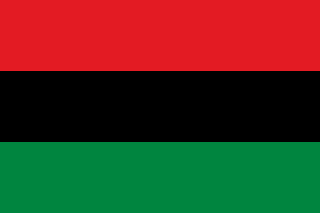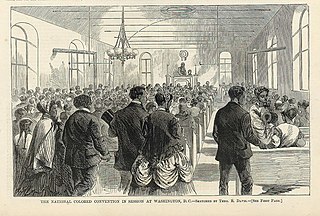
The Universal Declaration of Human Rights (UDHR) is an international document adopted by the United Nations General Assembly that enshrines the rights and freedoms of all human beings. Drafted by a UN committee chaired by Eleanor Roosevelt, it was accepted by the General Assembly as Resolution 217 during its third session on 10 December 1948 at the Palais de Chaillot in Paris, France. Of the 58 members of the United Nations at the time, 48 voted in favour, none against, eight abstained, and two did not vote.

The Pan-African flag is a tri-color flag consisting of three equal horizontal bands of red, black, and green. The Universal Negro Improvement Association and African Communities League (UNIA-ACL) formally adopted it on August 13, 1920, in Article 39 of the Declaration of the Rights of the Negro Peoples of the World, during its month-long convention at Madison Square Garden in New York City. Variations of the flag can and have been used in various countries and territories in the Americas to represent Garveyist ideologies.

The Universal Negro Improvement Association and African Communities League (UNIA-ACL) is a black nationalist fraternal organization founded by Marcus Garvey, a Jamaican immigrant to the United States, and Amy Ashwood Garvey. The Pan-African organization enjoyed its greatest strength in the 1920s, and was influential prior to Garvey's deportation to Jamaica in 1927. After that its prestige and influence declined, but it had a strong influence on African-American history and development. The UNIA was said to be "unquestionably, the most influential anticolonial organization in Jamaica prior to 1938," according to Honor Ford-Smith.

Pan-African colours is a term that may refer to two different sets of colours:

Garveyism is an aspect of black nationalism that refers to the economic, racial and political policies of UNIA-ACL founder Marcus Garvey. The ideology of Garveyism centers on the unification and empowerment of African-descended men, women and children under the banner of their collective African descent, and the repatriation of the descendants of enslaved Africans and profits to the African continent.

The flag of Kenya is a tricolour of black, red, and green with two white edges imposed with a red, white and black Maasai shield and two crossed spears. The flag is based on that of Kenya African National Union and was officially adopted on 12 December 1963 after Kenya's independence.
An African American is a citizen or resident of the United States who has origins in any of the black populations of Africa. African American-related topics include:

Pan-Africanism is a worldwide movement that aims to encourage and strengthen bonds of solidarity between all indigenous and diasporas of African ancestry. Based on a common goal dating back to the Atlantic slave trade, the movement extends beyond continental Africans with a substantial support base among the African diaspora in the Americas and Europe.
Declaration of Rights may refer to:

Henrietta Vinton Davis was an elocutionist, dramatist, and impersonator. In addition to being "the premier actress of all nineteenth-century black performers on the dramatic stage", Davis was proclaimed by Marcus Garvey to be the "greatest woman of the Negro race today".
Negro Factories Corporation was one of the business ventures of the Universal Negro Improvement Association and African Communities League recognized by 125 countries worldwide with its own Constitution and flag. The UNIA-ACL is a black nationalist fraternal organization founded in 1919 by Marcus Garvey, a North American Jamaican-born activist in New York. It eventually had chapters on three continents and in the Caribbean.
The Rastafari movement in the United States echoes the Rastafari religious movement, which began in Jamaica and Ethiopia during the 1930s. Marcus Garvey, born in Jamaica, was influenced by the Ethiopian king Haile Selassie. Jamaican Rastafaris began emigrating to the United States in the 1960s and 1970s, and established communities throughout the country.
The National Equal Rights League (NERL) is the oldest nationwide human rights organization in the United States. It was founded in Syracuse, New York in 1864 dedicated to the liberation of black people in the United States. Its origins can be traced back to the emancipation of slaves in the British West Indies in 1833. The league emphasized moral reform and self-help, aiming "to encourage sound morality, education, temperance, frugality, industry, and promote everything that pertains to a well-ordered and dignified life." Black leaders formed state and local branches of the league which drew many members, which caused the society to grow quickly, in areas such as Harrisburg, Pennsylvania, where people such as Thomas Morris Chester joined.
The National Black Political Convention, or the Gary Convention, was held on March 10–12, 1972 in Gary, Indiana. The convention gathered around ten thousand African-Americans to discuss and advocate for black communities that undergo significant economic and social crisis. Part of their goal was to raise the number of black politicians elected to office, increase representation, and create an agenda for fundamental change. The convention also issued the Gary Declaration, which stated that the American political system was failing black Americans and that the only way to address this problem was to transition to independent black politics. Notable participants in the convention included Gary mayor Richard Hatcher, civil rights activist Jesse Jackson, and House Representative Charles C. Diggs Jr. Diggs Jr., alongside Richard Hatcher, were the two keynote speakers at the National Black Political Convention.

Kwaku Walker Lewis, was an early African-American abolitionist, Freemason, and Mormon elder from Massachusetts. He was an active member of the Underground Railroad and the anti-slavery movement.

The Colored Conventions Movement, or Black Conventions Movement, was a series of national, regional, and state conventions held irregularly during the decades preceding and following the American Civil War. The delegates who attended these conventions consisted of both free and formerly enslaved African Americans, including religious leaders, businessmen, politicians, writers, publishers, editors, and abolitionists. The conventions provided "an organizational structure through which black men could maintain a distinct black leadership and pursue black abolitionist goals." Colored conventions occurred in thirty-one states across the United States and in Ontario, Canada. The movement involved more than five thousand delegates and tens of thousands of attendees.

Black Cross Nurses is an international organization of nurses which was founded in 1920, based upon the model of the Red Cross. The organization was the women's auxiliary of the Universal Negro Improvement Association and African Communities League and was established to provide health services and education to people of African descent.
Civil rights in the United States include noted legislation and organized efforts to abolish public and private acts of racial discrimination against Native Americans, African Americans, Asians, Latin Americans, women, the homeless, minority religions, and other groups since the independence of the country.
Peter Anderson was an African American rights activist who actively participated in California Colored Conventions Movements during the 1800s. Anderson was also the author of a newspaper called The Pacific Appeal which advocated black rights and helped activists network. Anderson and his coeditor Philip Alexander Bell argued often and eventually these disagreements led Bell to split off and create his own paper called The Elevator while Peterson continued with The Pacific Appeal.

The Pennsylvania State Equal Rights League Convention was a series of Colored Convention in the 19th-century. The convention was one of several social movement conventions that took place in the mid-19th century in many states across the United States.









